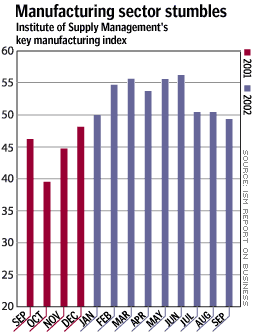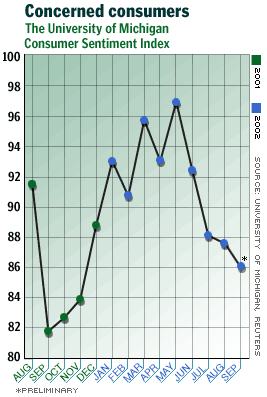NEW YORK (CNN/Money) -
U.S. consumers have carried the economy on their backs all year long, waiting for increased corporate spending to relieve some of the burden.
They're still waiting. Businesses, facing war, falling stock prices and other uncertainties, have declined to play the role of cavalry to the rescue.

Business reluctance was partially evident in reports this week from two groups of purchasing managers, one national and the other focusing on the U.S. Midwest, that showed manufacturing activity shrank in September for the first time since last winter.
And a Commerce Department report showed that a prolonged slump in the construction industry continued in August, with construction spending falling for the fourth straight month, led by a 2 percent plunge in spending on commercial projects.
Meanwhile, a slowdown in business spending is hurting other businesses, such as Electronic Data Systems Corp. (EDS: Research, Estimates). The company's stock has taken a beating in the days following its company's announcement that the market for its information technology systems is soft, and will stay that way for a while.
"It's obvious there's a lot of hand-to-mouth production going on, as businesses are still very wary about undertaking big projects or any sort of new activity for a variety of reasons, some intangible," said Robert DiClemente, chief economist at Salomon Smith Barney.
"It's consistent with other indicators that have suggested we don't have the real traction we need to get safely into higher gear on economic recovery," he added.
Consumers need relief
A slowdown in business spending after a glut in the late 1990s and early 2000 led to a dramatic excess of production capacity, a long recession in the manufacturing sector, a rash of job cuts, and a recession in the broader economy that began in March 2001.
Despite the recession, consumers have kept the economy from falling too far with their relentless spending, which comprises about two-thirds of total gross domestic product (GDP), the broadest measure of the economy.

In fact, no shock has been bad enough to deter the consumer from shopping -- not 1.8 million job cuts, not terror attacks, not corporate scandals such as those at Enron Corp. and WorldCom Group, not falling stock prices and not the possibility of war with Iraq -- yet.
But how long can this go on? Granted, consumer spending is unlikely to fall completely off the table -- it hasn't declined in any year since the Great Depression. But it can't carry the economy to a rip-roaring recovery without the help of businesses, who aren't reacting nearly as well to the same uncertainties.
"You can't sustain an economy driven only by motor vehicle purchases," said Michael Niemira, senior economist at Bank of Tokyo-Mitsubishi Ltd., referring to recent incentive-driven strength in automobile sales. "We're looking for [business spending to rise] in order to be confident about the second leg of the expansion going forth and, with it, the duration of expansion."
And businesses haven't exactly been going out of their way to help -- the ISM's employment index showed manufacturers were firing workers at a faster clip in September.
In what would seem to be a positive development for the labor market, job-cut announcements dropped 41 percent in September to their lowest level in 22 months, according to outplacement firm Challenger Gray & Christmas, which keeps track of corporate layoffs.
But the firm's CEO, John Challenger, cautioned against getting too excited about the drop, noting that the 70,057 layoffs announced in the month were nearly double the average rate of monthly job cuts announced between July 1990 and June 1992, during the last "jobless" economic recovery.
"The pattern of job cutting that we saw in the third quarter mirrors what we have been seeing almost daily in the various economic and corporate earnings reports, which is to say one report suggests the economy is headed toward recovery while the next seems to hint that we are stuck in recession," Challenger said in a statement.
Hopeful signs
Of course, the labor market is a lagging economic indicator, anyway -- businesses don't start hiring until there's no doubt the economy is gaining strength. The same could also be said for capital improvements.
"As time passes, excess capacity is being worked off and inventories are being accumulated once again ... [and] companies don't buy enhancements in technology or machinery until after they've seen a pickup in activity," said Sherry Cooper, chief economist at BMO Nesbitt Burns.
| Related stories
|

|
|
|
|
And there have been some signs that, even if businesses aren't spending like gangbusters yet, the worst of the spending slump might be over.
Even as EDS scrambled to bandage its wounded stock price, shares of data-storage firm Network Appliance Inc. (NTAP: Research, Estimates) jumped after its CEO Dan Warmenhoven told Reuters he saw stabilization in the data-storage market -- even though the rest of the IT market could be in the doldrums for "a couple of years."
One measure of business spending, the "non-residential fixed investment" component of GDP, shrank in the second quarter, but at the slowest pace since the fourth quarter of 2000, when the prolonged downturn in capital investment began.
Companies so far have been able to improve productivity and keep costs down by laying off workers. At some point, however, they'll have to find another way to increase profit and productivity, since they can't simply lay off all their workers.
"Once you've cut employees as much as you can, the only thing left to do when you don't have pricing power is to become more productive, and you do that through capital spending," said Steve East, chief economist at Friedman Billings Ramsey.
East said he expects the business spending component of GDP to show growth at a 2 percent annual pace in the third quarter, the best performance since the third quarter of 2000.
Such news would certainly go a long way toward making economists, equity markets, consumers and businesses feel a little better about the economy's prospects. Until such reports become the norm, however, there could be some nervous times for all of the above.
"The economy's long-range future is excellent, and we have a lot of things going for us," said Delos Smith, economist at the Conference Board. "But we're waiting for the water to boil, and you can get very flustered if you watch water boil."

|

